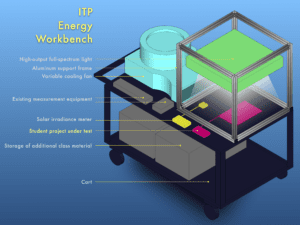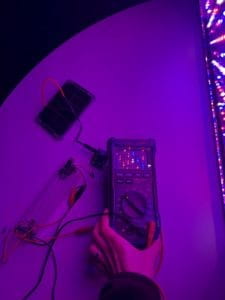by Jeff Feddersen
I’ve taught an “Energy” course at ITP for several years, and over that time I’ve noticed that there tend to be a few recurring problems when students tackle solar-powered projects. Students typically underestimate the difference between indoor and outdoor light levels; it is inconvenient to take prototypes outside to test, let alone work on them outdoors; they work at odd hours and at the last minute, meaning even with the best intentions and professor deadlines solar projects spend little if any time in direct sun if and when they are working.
 The program has a single, soon-to-be-retired solar panel on the roof of 721 Broadway, but roof access is restricted, so Professor Tom Igoe and I thought it would be helpful to bring the sun to the students. There are lab-grade sun simulators that perfectly emulate the power and spectra of outdoor light, but these cost in the six figures to test small individual PV cells. Metal-halide grow lights, another possibility, are cumbersome and dangerous. Some research suggests that newly-available LED lights might yield 80-100% typical solar irradiance as measured in watts/ m2.
The program has a single, soon-to-be-retired solar panel on the roof of 721 Broadway, but roof access is restricted, so Professor Tom Igoe and I thought it would be helpful to bring the sun to the students. There are lab-grade sun simulators that perfectly emulate the power and spectra of outdoor light, but these cost in the six figures to test small individual PV cells. Metal-halide grow lights, another possibility, are cumbersome and dangerous. Some research suggests that newly-available LED lights might yield 80-100% typical solar irradiance as measured in watts/ m2.
With that light as an option, we designed the ITP Energy Workbench. The mobile workstation provides an adjustable high-powered light that approaches the AM1.5 values used to specify solar panel power, and allows students to test small- to medium-sized projects indoors. We also added several items of test equipment – a calibrated solar irradiance meter, temperature probe, variable DC load, two-way charge monitor, and data-logging power outlets that record power consumption over time. Most of these items are useful to any project trying to characterize its energy use, not just solar.
 Several graduate students helped assemble and test the workbench, in particular Brent Bailey, who has documented the process, and James Hoskin. During the assembly process, it was found that the light was indeed capable of producing >900 watts/m2 and driving solar panels to their rated short circuit current and open circuit voltage. The light was bright enough that additional eye-protection is being added to the light frame to prevent glare from bothering other students (three sets protective glasses are available for operators). Also, while the light is clearly not a spectral match for sunlight, there is enough IR in the output to work for the most typical types of PV, and the purplish cast to the light is appropriate for an NYU project.
Several graduate students helped assemble and test the workbench, in particular Brent Bailey, who has documented the process, and James Hoskin. During the assembly process, it was found that the light was indeed capable of producing >900 watts/m2 and driving solar panels to their rated short circuit current and open circuit voltage. The light was bright enough that additional eye-protection is being added to the light frame to prevent glare from bothering other students (three sets protective glasses are available for operators). Also, while the light is clearly not a spectral match for sunlight, there is enough IR in the output to work for the most typical types of PV, and the purplish cast to the light is appropriate for an NYU project.
The workbench came together towards the end of the semester, but several students were able to use parts of it to test their midterm and final projects for the Energy class. As the cart has applications for several other classes such as Physical Computing and Basic Analog Electronics, we plan to see further use in the upcoming fall semester.
NYU Green Grants are awarded to improve the university’s operational environmental performance, foster environmental literacy and community engagement, advance applied research and design, and demonstrate the viability of best practices and technologies for sustainability. The Green Grants Selection Committee awards up to $20,000 for the most feasible, impactful, and innovative projects that have potential for institutionalization on campus or are self-sustaining.
Jeff Feddersen is an ITP alum and has taught a version of the Energy class ever since the East Coast blackout.
